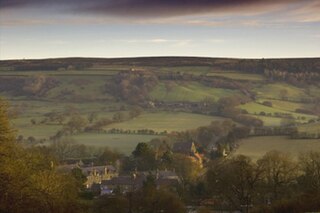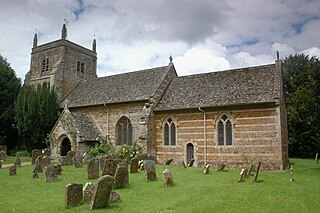
Lower Catesby is a hamlet in the civil parish of Catesby, Northamptonshire, about 4 miles (6.4 km) southwest of Daventry. Lower Catesby is beside the nascent River Leam, which rises about 1 mile (1.6 km) to the south in the parish of Hellidon. The Jurassic Way long-distance footpath passes through Lower Catesby. The population of the hamlet is included in the civil parish of Hellidon.
Sopwell Priory was a Benedictine nunnery founded around 1140 on the site of an ancient hermitage in Sopwell, Hertfordshire, England. After the Dissolution, the priory was torn down and a Tudor manor house constructed in its place.

Arthington Priory was an English monastery which was home to a community of nuns in Arthington, West Yorkshire, founded in the mid-12th century. The priory land is occupied by a residence called "Arthington Hall", which was built around 1585, and little, if anything, remains of the priory. The site of the priory church is possibly now occupied by a farmhouse called The Nunnery. The community was the only one of nuns of the Cluniac congregation in Yorkshire and one of two in England. It was established through a grant by Peter de Arthington.

Sandford-on-Thames, also referred to as simply Sandford, is a village and Parish Council beside the River Thames in Oxfordshire just south of Oxford. The village is just west of the A4074 road between Oxford and Henley.

Börringe Priory was a medieval Benedictine priory founded in 1150 at Svedala in Scania, Sweden. Secularized in 1536, the site was developed as a home for the Brahe family. The present large building, known as Börringeklosters slott, was built here in 1763.
Amesbury Priory was a Benedictine monastery at Amesbury in Wiltshire, England, belonging to the Order of Fontevraud. It was founded in 1177 to replace the earlier Amesbury Abbey, a Saxon foundation established about the year 979. The Anglo-Norman Amesbury Priory was disbanded at the Dissolution of the monasteries and ceased to exist as a monastic house in 1539.

Rosedale Abbey is a village in the Ryedale district of North Yorkshire, England. It is approximately 8 miles (13 km) north-west of Pickering, 8 miles south-east of Castleton and within Rosedale, part of the North York Moors National Park.

Duns Tew is an English village and civil parish about 7+1⁄2 miles (12 km) south of Banbury in Oxfordshire. The 2011 Census recorded the parish's population as 478. With nearby Great Tew and Little Tew, Duns Tew is one of the three villages known collectively as "The Tews". A 'tew' is believed to be an ancient term for a ridge of land.

Carlton in Lindrick is a village and civil parish about 3 miles (5 km) north of Worksop in Nottinghamshire, England. The 2011 Census recorded a parish population of 5,623, including nearby Wallingwells. The 2021 Census reported alone on Carlton in Lindrick, with 5,635 residents.
Wintney Priory was a priory of Cistercian nuns in Hartley Wintney, Hampshire, England.

Horton-cum-Studley is a village and civil parish in Oxfordshire about 6+1⁄2 miles (10.5 km) northeast of the centre of Oxford and bordering Otmoor, and is one of the "Seven Towns" of Otmoor. The 2011 Census recorded the parish's population as 455. A majority of residents in the village work in the Healthcare and Educational Sectors.
Ickleton Priory was a Benedictine priory of nuns at Ickleton, Cambridgeshire, England. It was established in the middle of the 12th century and suppressed in the Dissolution of the Monasteries in 1536.
St. George's Priory, Thetford was a Benedictine priory on the Suffolk side of Thetford, England. It was located at the current site of the British Trust for Ornithology, South of Nuns Bridges Road.
Catesby Priory was a priory of Cistercian nuns at Lower Catesby, Northamptonshire, England. It was founded in about 1175 and dissolved in 1536.

Over Worton is a hamlet in the civil parish of Worton, in the West Oxfordshire district, in the county of Oxfordshire, England, about 7 miles (11 km) south of Banbury and 7+1⁄2 miles (12 km) east of Chipping Norton. In 1931 the parish had a population of 72. On 1 April 1932 the parish was abolished and merged with Nether Worton to form "Worton".
St Leonard's Priory was a Benedictine nunnery in what is now east London, which gave its name to Bromley St Leonard.

The Church of St Mary and St Nicholas is a Church of England parish church in Littlemore, Oxford, Oxfordshire. The church is a grade II* listed building. The church was founded by John Henry Newman, later Cardinal Newman of the Roman Catholic Church, and it became a centre of Anglo-Catholicism.

The Keldholme Priory election dispute occurred in Yorkshire, England, in 1308. After a series of resignations by its prioresses, the establishment was in a state of turmoil, and the Archbishop of York, William Greenfield, appointed one of the nuns to lead the house. His candidate, Emma de Ebor', was deemed unacceptable by many nuns, who undermined her from the start to the extent that she resigned three months later. The archbishop, forced to find another candidate, claimed that he was unable to do so from within the priory and appointed Joan de Pykering from nearby Rosedale Priory. It is likely that Keldholme saw de Pykering as an intruder, and it seems to have reacted against her in much the same way as to her predecessor.

The Littlemore Priory scandals took place between 1517 and 1518. They involved accusations of sexual immorality and sometimes brutal violence among the Benedictine nuns and their prioress at St Nicholas' Priory in Littlemore, in Oxfordshire, England. The priory was very small and poor, and had a history of troubled relations with its bishops, dating back to the mid-1400s. The scandal that came to light in 1517, however, became enough of a cause célèbre to contribute to the priory's eventual suppression in 1525. Katherine Wells, the prioress of Littlemore at that time, ran the priory with strict and often violent discipline. She was accused of regularly putting nuns in the stocks for extended periods, as well as physically assaulting them. She also had a baby by the priory's chaplain and had pawned the priory's jewels to pay for the child's upbringing. She entertained men in her parlour, even after the bishop had been made aware of the accusations, which involved heavy drinking. At least one other nun also had a child. On one occasion a number of the nuns broke out of the priory through a window and escaped into the surrounding villages for some weeks.



















